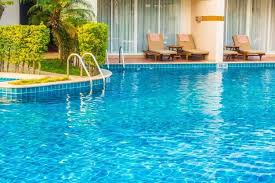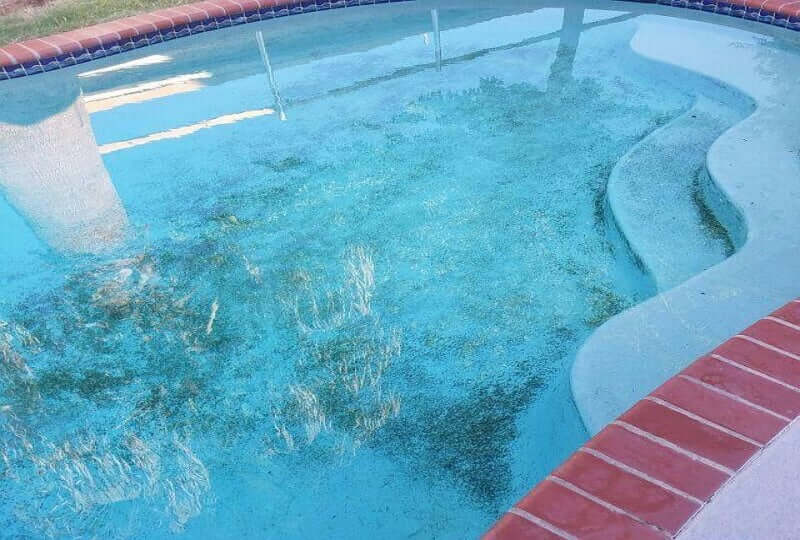Have you ever peeked at your backyard oasis, expecting to see sparkling blue water, only to discover patches of fuzzy green stuff clinging to your pool tiles? That unwelcome greenery isn't just ruining your pool aesthetic – it's a sign that Mother Nature is trying to reclaim your swimming territory! But what exactly is that green stuff, and why is it so darn persistent?
Moss vs. Algae: Know Your Enemy
First things first – let's clear up a common confusion. That green stuff in your pool? It might not actually be moss. In fact, what most pool owners call "moss" is typically algae. While they're both unwanted green invaders, they're actually quite different critters in the plant kingdom.
According to pool experts, true moss is rare in swimming pools. Moss is a land-dwelling plant with tiny leaflet structures that form soft, velvety patches. It requires both moisture and a solid surface to grow, which is why you might find it on pool decks or surrounding areas, but rarely in the pool itself.
What's more likely invading your swimming pool is algae – single-celled plant-like organisms that thrive in water. These microscopic troublemakers can appear as green slime, black spots, or even yellowish-brown patches on your pool surfaces.
As Serapool Porcelain explains, "Those living in water are called algae and those living on land are called mosses. They grow in velvety soft layers or dense clumps." This distinction is important because the treatment methods differ based on what you're dealing with.
Why Is Green Stuff Growing in My Pool?
Whether it's algae or (rarely) actual moss, there are several reasons why you're seeing green in your swimming pool:
- Imbalanced Water Chemistry: When your pool's pH level strays from the ideal range of 7.2-7.6, you're rolling out the welcome mat for algae. High pH and low chlorine create the perfect environment for algae to throw a pool party.
- Inadequate Filtration: Your filter system is like your pool's immune system. When it's not working properly, contaminants that contribute to algae growth stay in the water instead of being removed.
- Poor Circulation: Dead spots in your pool with little water movement become prime real estate for algae colonies. Without proper circulation, chlorine can't effectively reach all areas.
- Uninvited Guests: Algae spores are everywhere – floating in the air, hitching rides on leaves, and catching lifts on swimwear. Even the cleanest pools face constant algae bombardment.
- Weather Conditions: Warm temperatures, sunlight, and rain can create ideal growing conditions. After a rainstorm, nitrogen compounds in the rain can mix with pool water and turn into nitrates – algae's favorite food.
- Neglected Maintenance: Let's be honest – sometimes life gets busy, and pool maintenance takes a backseat. Even a week of neglect during hot weather can lead to a full-blown algae bloom.
The Different Shades of Green: Types of Pool Algae
Not all green stuff is created equal. Understanding what type of algae you're battling helps you choose the right weapons:
Green Algae
The most common invader, green algae can float freely in your water (turning it cloudy green) or cling to walls and floors. It's slippery to the touch and spreads rapidly, especially during warm, sunny weather. While it's the easiest type to eliminate, it's also the quickest to take over your pool if left unchecked.
Black Algae
Despite its name, black algae often appears dark blue-green or black with spots. This stubborn foe develops roots that dig into concrete and grout, making it extremely difficult to eliminate. According to pool maintenance experts, "Black algae has a durable protective layer that makes it difficult to scrub, with strong roots anchoring it to your pool walls."
Yellow/Mustard Algae
This sneaky algae variety looks like pollen or sand on pool surfaces, typically in shaded areas. Don't be fooled by its innocent appearance – it's actually harder to kill than green algae and can return if not completely eradicated.
Pink "Algae"
Plot twist – pink algae isn't algae at all! It's actually bacteria that forms pinkish slime in corners and crevices. While less common than true algae, it requires specific treatment approaches.
Moss on the Deck: A Different Problem
While algae dominates inside the pool, true moss is more likely to appear on your pool deck, especially in shaded, moist areas or in the cracks between pavers or tiles. This creates slippery conditions that can be hazardous to swimmers.
As Wet & Forget notes, "Moss is typically green but can be black, brown, or yellow. They have tiny leaflets and require sun and moisture to survive." These plants can create safety hazards when wet and, if allowed to spread, can eventually make their way into your pool water.
The Clear and Present Danger: Why You Should Act Now
Beyond being an eyesore, algae and moss pose several problems for pool owners:
- Safety Hazards: Slippery surfaces can lead to falls and injuries.
- Equipment Damage: Algae can clog filters and pumps, forcing them to work harder and potentially shortening their lifespan.
- Structural Issues: Some algae varieties, particularly black algae, can penetrate surfaces and cause lasting damage to pool materials.
- Health Concerns: While most algae aren't directly harmful, they can harbor bacteria that might cause skin irritation or other health issues.
- Water Quality: Algae compete with chlorine, potentially making your pool water less safe for swimming.
- Higher Maintenance Costs: Once established, algae requires more chemicals and more frequent cleaning, driving up your pool care expenses.
Battle Plan: Eliminating Moss and Algae from Your Pool
Ready to reclaim your aquatic territory? Here's your step-by-step strategy for a complete green invader takedown:
Step 1: Test and Balance Your Water
Before grabbing any chemicals, test your pool water. You're looking for:
- pH between 7.2 and 7.6
- Alkalinity between 80-120 ppm
- Chlorine level between 1-3 ppm
- Cyanuric acid (stabilizer) between 30-50 ppm
Adjusting these levels creates an environment where algae can't thrive and your cleaning efforts will be more effective.
Step 2: Brush, Brush, Brush
For algae on pool surfaces:
- Use a stiff-bristled brush on concrete or plaster pools
- Use a nylon brush for vinyl, fiberglass, or painted surfaces
- Scrub vigorously in a circular motion to loosen the algae's grip
- Pay special attention to corners, steps, and other areas where algae tends to concentrate
For moss on decks or surrounding areas:
- Use a deck brush with stiff bristles to remove surface growth
- For stubborn patches, a pressure washer can be effective (but use with caution on delicate surfaces)
Step 3: Vacuum and Filter
After brushing:
- Vacuum the pool manually to remove loosened algae
- Clean or backwash your filter regularly during treatment (algae will quickly clog it)
- Run your filter continuously during treatment
Step 4: Shock the System
Pool shock is your nuclear option against algae:
- Use 2-3 times the normal amount of chlorine shock for green algae
- For black or yellow algae, you may need up to 4 times the normal amount
- Add shock at dusk or night for maximum effectiveness (sunlight degrades chlorine)
- Keep the filter running 24/7 during treatment
Step 5: Algaecide Application
After shocking:
- Wait until chlorine levels drop below 5 ppm
- Apply an algaecide following package directions
- Different algaecides target different types of algae, so choose accordingly
Step 6: For Stubborn Tile Grout Algae
For those persistent green lines in your tile grout:
- Lower the water level below the affected area
- Apply a chlorine tablet directly to the grout by rubbing its edge along the line
- Let it sit for several hours or overnight
- Scrub with a brush and rinse thoroughly
Step 7: Prevent Future Invasions
Once your pool is algae-free, maintain your victory with these preventive measures:
- Test and balance water weekly
- Shock your pool regularly (at least monthly, more frequently during hot weather)
- Run your filter at least 8-12 hours daily
- Clean and backwash filters regularly
- Brush pool surfaces weekly
- Use a quality pool cover when not in use
The Xbenbot Solution: Your Secret Weapon Against Green Invaders
While manual cleaning is effective, wouldn't it be nice to have some high-tech help in the ongoing battle against algae? That's where the Xbenbot Hydro-Puls Robotic Pool Cleaner comes in.
This innovative robotic cleaner doesn't just vacuum debris – it actively scrubs surfaces with rotating brushes that dislodge algae before it can establish a foothold. By maintaining consistent cleaning cycles, the Hydro-Puls prevents the conditions that allow algae to thrive in the first place.
The Hydro-Puls features:
- Advanced scrubbing technology that removes algae from surfaces
- Efficient filtration that removes microscopic particles before they become problems
- Smart navigation that ensures complete coverage, including walls and waterline
- Energy-efficient operation that saves you money while keeping your pool pristine
By investing in a Hydro-Puls, you're not just buying a pool cleaner – you're deploying a preventative maintenance system that works around the clock to keep algae at bay.
Beyond the Pool: Tackling Moss in Surrounding Areas
For those dealing with actual moss on pool decks, coping stones, or nearby landscaping, here are some effective strategies:
- Trim Overhanging Vegetation: Reducing shade helps create conditions less favorable for moss growth.
- Improve Drainage: Fix any areas where water pools on your deck or patio.
- Regular Cleaning: A quarterly cleaning of deck surfaces prevents moss from establishing a foothold.
- Moss-Killing Solutions: Products containing zinc sulfate or potassium salts can effectively kill moss without harming surrounding plants.
- Pressure Washing: For established moss, pressure washing can remove it effectively, especially from concrete or stone surfaces.
The Final Word: Prevention Is Your Best Defense
When it comes to pool moss and algae, the old saying rings true: an ounce of prevention is worth a pound of cure. Establishing a regular maintenance routine with your Xbenbot Hydro-Puls is far easier than battling a full-blown algae invasion.
Remember these key preventive measures:
- Consistent water testing and balancing
- Regular brushing and cleaning
- Proper circulation and filtration
- Coverage when not in use
- Prompt attention to any early signs of algae
By following these guidelines and leveraging the power of Xbenbot technology, you can ensure your pool remains a crystal-clear oasis, free from unsightly green invaders. Your pool should be a source of relaxation and enjoyment – not a science experiment in algae cultivation!
Now, who's ready to dive into clean, clear water? Your algae-free swimming adventure awaits!




Leave a comment
This site is protected by hCaptcha and the hCaptcha Privacy Policy and Terms of Service apply.